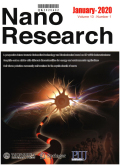- 钛学术文献服务平台 \
- 学术期刊 \
- 基础科学期刊 \
- 物理学期刊 \
- 纳米研究(英文版)期刊 \
Efficient photovoltaic effect in graphene/h-BN/silicon heterostructure self-powered photodetector
Efficient photovoltaic effect in graphene/h-BN/silicon heterostructure self-powered photodetector
基本信息来源于合作网站,原文需代理用户跳转至来源网站获取
摘要:
Graphene (Gr)/Si-based optoelectronic devices have attracted a lot of academic attention due to the simpler fabrication processes,low costs,and higher performance of their two-dimensional (2D)/three-dimensional (3D) hybrid interfaces in Schottky junction that promotes electron--hole separation.However,due to the built-in potential of Gr/Si as a photodetector,the Iph//dark ratio is often hindered near zero-bias at relatively low illumination intensity.This is a major drawback in self-powered photodetectors.In this study,we have demonstrated a self-powered van der Waals heterostructure photodetector in the visible range using a Gr/hexagonal boron nitride (h-BN)/Si structure and clarified that the thin h-BN insertion can engineer asymmetric carrier transport and avoid interlayer coupling at the interface.The dark current was able to be suppressed by inserting an h-BN insulator layer,while maintaining the photocurrent with minimal decrease at near zero-bias.As a result,the normalized photocurrent-to-dark ratio(NPDR) is improved more than 104 times.Also,both Ipd//dark ratio and detectivity,increase by more than 104 times at-0.03 V drain voltage.The proposed Gr/h-BN/Si heterostructure is able to contribute to the introduction of next-generation photodetectors and photovoltaic devices based on graphene or silicon.

推荐文章
h-BN 薄膜表面 PMMA 残留去除研究
六方氮化硼
转移
PMMA
残留物
高压气-固燃烧合成h-BN-SiO2和h-BN陶瓷材料的研究
h-BN陶瓷
h-BN-SiO2陶瓷
高压气-固燃烧合成
TiB2/WC/h-BN自润滑陶瓷材料的制备及力学性能
二硼化钛
自润滑
陶瓷材料
力学性能
h-BN的制备与表征
六方氮化硼
合成
硼酸
内容分析
关键词云
关键词热度
相关文献总数
(/次)
(/年)
引文网络
引文网络
二级参考文献 (0)
共引文献 (0)
参考文献 (39)
节点文献
引证文献 (0)
同被引文献 (0)
二级引证文献 (0)
1980(1)
- 参考文献(1)
- 二级参考文献(0)
1995(2)
- 参考文献(2)
- 二级参考文献(0)
1999(1)
- 参考文献(1)
- 二级参考文献(0)
2007(1)
- 参考文献(1)
- 二级参考文献(0)
2010(2)
- 参考文献(2)
- 二级参考文献(0)
2011(1)
- 参考文献(1)
- 二级参考文献(0)
2012(1)
- 参考文献(1)
- 二级参考文献(0)
2013(8)
- 参考文献(8)
- 二级参考文献(0)
2014(4)
- 参考文献(4)
- 二级参考文献(0)
2015(2)
- 参考文献(2)
- 二级参考文献(0)
2016(6)
- 参考文献(6)
- 二级参考文献(0)
2017(4)
- 参考文献(4)
- 二级参考文献(0)
2018(3)
- 参考文献(3)
- 二级参考文献(0)
2019(3)
- 参考文献(3)
- 二级参考文献(0)
2021(0)
- 参考文献(0)
- 二级参考文献(0)
- 引证文献(0)
- 二级引证文献(0)
引文网络交叉学科
相关学者/机构
期刊影响力
纳米研究(英文版)
主办单位:
清华大学
出版周期:
月刊
ISSN:
1998-0124
CN:
11-5974/O4
开本:
出版地:
北京市海淀区清华大学学研大厦A座5-7层
邮发代号:
创刊时间:
语种:
eng
出版文献量(篇)
2324
总下载数(次)
1
总被引数(次)
5935
期刊文献
相关文献
推荐文献

 免费查重
免费查重










